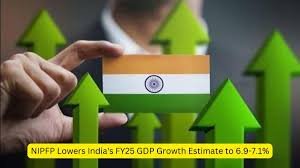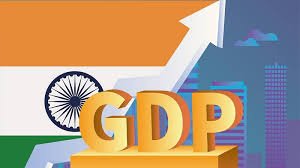NIPFP Lowers India’s FY25 GDP Growth Estimate to 6.9-7.1%
The National Institute of Public Finance and Policy (NIPFP) has recently revised its growth forecast for India’s Gross Domestic Product (GDP) for the fiscal year 2024-25 (FY25). The new estimate stands at a range of 6.9% to 7.1%, a downward adjustment from previous forecasts. This revision comes amid concerns over slowing demand and global economic uncertainties that have influenced economic performance.
Impact of External Factors on GDP
One of the significant factors contributing to this downward revision is the ongoing global economic slowdown, which has affected key sectors in India, particularly exports and manufacturing. The International Monetary Fund (IMF) has also projected a moderate slowdown in global growth, impacting emerging economies like India. The NIPFP highlighted that while domestic consumption remains robust, external factors could hinder overall economic expansion.
Sector-Specific Concerns
The report emphasizes specific sectors that are facing challenges, such as real estate and infrastructure, which are crucial for driving economic growth. The housing market has been sluggish, and infrastructure projects have experienced delays, affecting overall investment sentiment. The government’s initiatives to boost these sectors are essential for reviving growth momentum in FY25.
Government’s Response and Policy Adjustments
In response to these challenges, the Indian government is expected to implement targeted policies aimed at stimulating growth. Initiatives such as infrastructure investment, tax reforms, and measures to enhance export competitiveness could play a vital role in addressing the slowdown. The NIPFP also stressed the importance of maintaining fiscal discipline while promoting growth-oriented policies.
Conclusion
As India navigates through these challenges, the revised GDP growth estimate serves as a crucial reminder of the need for adaptive economic policies. The focus must remain on sustaining growth through proactive measures while being aware of global economic dynamics.

Why This News is Important
Economic Stability
The adjustment of GDP growth forecasts by NIPFP is significant for policymakers and stakeholders in India. A lower growth estimate could influence government strategies, fiscal policies, and monetary measures, crucial for economic stability and recovery. Understanding these adjustments is essential for students and future civil servants to grasp how economic forecasts can impact national planning and budgeting.
Employment Implications
A decline in GDP growth can have direct implications on employment rates in India. Sluggish economic growth often leads to slower job creation, which is critical for a country with a large workforce. Students preparing for government exams should recognize the correlation between GDP growth and employment, particularly in sectors such as education, policing, and public service.
Investment Insights
For students aspiring to enter the banking and finance sectors, knowledge of GDP growth trends and economic health is vital. Investment decisions are often influenced by GDP forecasts, and understanding these economic indicators will equip students with insights necessary for making informed financial decisions in their future careers.
Historical Context
Previous GDP Growth Estimates
In previous years, India had witnessed robust economic growth, frequently surpassing the 7% mark. However, as global economic conditions shifted, projections began to reflect more cautious estimates. The impact of the COVID-19 pandemic in 2020 significantly disrupted economic activities, causing a substantial decline in GDP. The recovery phase saw varied growth rates as India adapted to post-pandemic challenges.
Global Economic Trends
The global economic landscape has also changed, with several advanced economies experiencing slowdowns due to rising inflation and geopolitical tensions. These trends have a cascading effect on developing nations, including India, which rely on exports and foreign investments to fuel growth. Understanding these historical trends provides context to the current GDP forecast adjustments and highlights the interconnectedness of global economies.
Key Takeaways from “NIPFP Lowers India’s FY25 GDP Growth Estimate to 6.9-7.1%”
| Serial Number | Key Takeaway |
|---|---|
| 1 | NIPFP has revised India’s FY25 GDP growth estimate to 6.9%-7.1%. |
| 2 | Global economic slowdown is a significant factor influencing this revision. |
| 3 | Key sectors like real estate and infrastructure are facing substantial challenges. |
| 4 | The Indian government may implement targeted policies to stimulate growth. |
| 5 | Understanding GDP trends is crucial for future civil servants and economic policymakers. |
Important FAQs for Students from this News
Q1: What is the current GDP growth estimate for India according to NIPFP for FY25?
A1: The National Institute of Public Finance and Policy (NIPFP) has revised India’s GDP growth estimate for FY25 to a range of 6.9% to 7.1%.
Q2: What factors contributed to the downward revision of the GDP growth estimate?
A2: The revision was influenced by a global economic slowdown, challenges in key sectors such as real estate and infrastructure, and external uncertainties affecting domestic demand.
Q3: How might the revised GDP growth impact employment in India?
A3: A lower GDP growth rate could lead to slower job creation, affecting employment opportunities, particularly in sectors reliant on economic expansion.
Q4: What measures is the Indian government likely to implement in response to the GDP revision?
A4: The government may introduce targeted policies to stimulate growth, including increased infrastructure investment, tax reforms, and measures to enhance export competitiveness.
Q5: Why is understanding GDP growth important for students preparing for government exams?
A5: Understanding GDP growth trends is crucial for future policymakers and civil servants as it impacts national planning, budgeting, and employment strategies.
Some Important Current Affairs Links


















